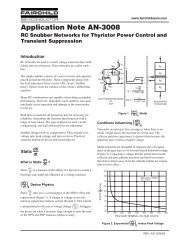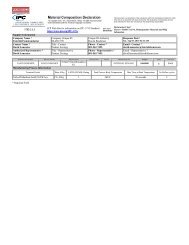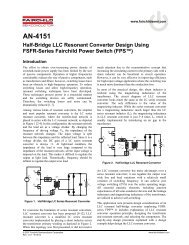AN-9732 - Fairchild Semiconductor
AN-9732 - Fairchild Semiconductor
AN-9732 - Fairchild Semiconductor
You also want an ePaper? Increase the reach of your titles
YUMPU automatically turns print PDFs into web optimized ePapers that Google loves.
<strong>AN</strong>-<strong>9732</strong> APPLICATION NOTE<br />
Appendix 2: Gate Driver Design<br />
FL7930 directly drives the gate of the MOSFET and various<br />
combinations of gate driver circuits are possible. Figure 33<br />
and Figure 31 show the three circuits that are widely used.<br />
When only one resistor is used, the turn-on and turn-off<br />
paths follow the same routine and turn-on and turn-off speed<br />
cannot be changed simultaneously. To cover this, make<br />
different paths by two resistors and diode if possible. Turnoff<br />
current flows through the diode first, instead of RON, and<br />
then RON and ROFF show together. Accordingly, faster turn<br />
off is possible. However, turn-off path using internal gate<br />
driver’s sinking path and current is limited by sinking<br />
current capability. If a PNP transistor is added between the<br />
gate and source of the MOSFET, the gate is shorted to<br />
source locally without sharing the current path to the gate<br />
driver. This makes the gate discharge to the much smaller<br />
path than that made by the controller. The possibility of<br />
ground bounce is reduced and power dissipation in the gate<br />
driver is reduced. Due to new high-speed MOSFET types<br />
such as SupreMOS ® or SuperFET , gate speed is getting<br />
fast. This decreases the switching loss of the MOSFET. At<br />
the same time, power systems suffer from the EMI<br />
deterioration or noise problems, like gate oscillation.<br />
Therefore, sometimes a gate discharge circuit is inevitable<br />
to use high-speed characteristics fully.<br />
Figure 33. Equivalent Circuit of Line Filter Stage<br />
The most difficult and uncertain task in direct gate drive is<br />
optimizing circuit layout. Gate driving path from the OUT<br />
pin, resistor, MOSFET gate, and MOSFET source to the<br />
GND pin should be as short as possible to reduce parasitic<br />
inductance; which may make MOSFET on/off speed slow<br />
or introduce unwanted gate oscillation. Using a wider PCB<br />
pattern for this lane reduces parasitic inductance. To damp<br />
unwanted gate oscillation made by the capacitance at the<br />
gate pin and parasitic inductance formed by MOSFET<br />
internal bonding wire and PCB pattern, proper resistance<br />
can match the impedance at the resonant frequency. To meet<br />
EMI regulations or for the redundant system, fast gate speed<br />
can be sacrificed by increasing serial resistance between the<br />
gate driver and gate.<br />
An optimal gate driver circuit needs intensive knowledge of<br />
MOSFET turn-on/off characteristics and consideration of<br />
the other critical performance requirements of the system.<br />
This is beyond the scope of this paper and many reference<br />
papers can be found in the industry literature.<br />
© 2011 <strong>Fairchild</strong> <strong>Semiconductor</strong> Corporation www.fairchildsemi.com<br />
Rev. 1.0.0 • 3/23/11 18







